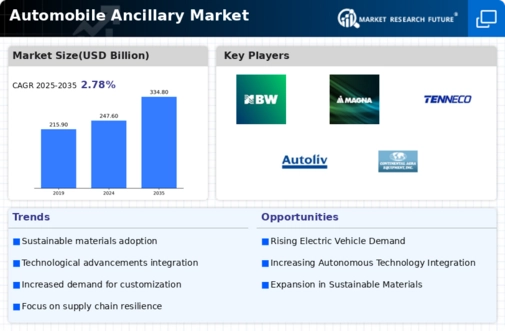Market Growth Chart
Global Economic Recovery
The Global Automobile Ancillary Market Industry is poised to benefit from the anticipated global economic recovery. As economies stabilize and consumer confidence returns, spending on automobiles is expected to rise. Projections suggest that by 2035, the market could reach 334.8 USD Billion, reflecting a compound annual growth rate of 2.78% from 2025 to 2035. This recovery is likely to stimulate demand for both new vehicles and ancillary components, as consumers prioritize mobility solutions. The interplay between economic conditions and automotive demand underscores the importance of monitoring macroeconomic indicators to gauge market potential.
Rising Aftermarket Demand
The Global Automobile Ancillary Market Industry is significantly bolstered by the rising demand for aftermarket products and services. As vehicle ownership increases globally, the need for maintenance, repairs, and upgrades becomes more pronounced. This trend is particularly evident in regions with a growing middle class, where consumers are investing in vehicle enhancements. The aftermarket segment, which includes parts such as filters, brakes, and performance upgrades, is projected to expand, contributing to the overall market growth. This increasing focus on vehicle longevity and performance indicates a robust opportunity for ancillary suppliers.
Growing Vehicle Production
The Global Automobile Ancillary Market Industry experiences a notable boost due to the increasing production of vehicles worldwide. In 2024, the market is projected to reach 247.6 USD Billion, driven by rising consumer demand for personal and commercial vehicles. Countries like China and India are leading this growth, with significant investments in manufacturing capabilities. As vehicle production ramps up, the demand for ancillary components such as tires, batteries, and electronic systems also rises, indicating a symbiotic relationship between vehicle manufacturing and the ancillary market. This trend is expected to continue, supporting the overall market expansion.
Sustainability Initiatives
Sustainability initiatives are increasingly influencing the Global Automobile Ancillary Market Industry. Governments worldwide are implementing stricter emissions regulations and promoting eco-friendly vehicle technologies. This shift encourages manufacturers to adopt sustainable practices in their production processes. For example, the use of recycled materials in automotive components is gaining traction, which not only reduces environmental impact but also aligns with consumer preferences for greener products. As sustainability becomes a core focus, ancillary suppliers that prioritize eco-friendly solutions may find themselves at a competitive advantage, potentially driving market growth.
Technological Advancements
Technological innovation plays a pivotal role in shaping the Global Automobile Ancillary Market Industry. The integration of advanced technologies such as electric vehicle components, autonomous driving systems, and connected vehicle technologies is driving demand for specialized ancillary products. For instance, the shift towards electric vehicles necessitates the development of new battery technologies and charging infrastructure. This evolution not only enhances vehicle performance but also creates opportunities for ancillary suppliers to innovate and diversify their offerings. As these technologies mature, they are likely to contribute significantly to the market's growth trajectory.







